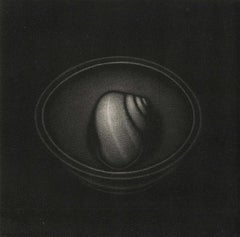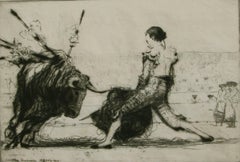Richard Davies Animal Prints
to
1
1
Overall Width
to
Overall Height
to
1
10
194
161
118
94
1
1
1
1
1
1
1
1
1
1
1
1
Artist: Richard Davies
Small Soldier Travelling in a Fish - Original Handsigned Etching - Ltd 60 copies
By Richard Davies
Located in Paris, IDF
Richard DAVIES (1945-1991)
Small Soldier Travelling in a Fish
Original etching and mezzotint
Handsigned in pencil
Numbered / 60
On vellum 41 x 33 cm (c. 16 x 13 inch)
REFERENCES : ...
Category
1980s Modern Richard Davies Animal Prints
Materials
Mezzotint, Etching
Related Items
Snail in a Bowl (Artist Proof inscribed to Fritz Eichenberg)
Located in New Orleans, LA
Leonard Merchant's mezzotint, "Snail in Cup" is inscribed for fellow artist, Fritz Eichenberg.
While a student at the Central School for Arts and Crafts in London, a young Leonard Marchant found an engraving rocker in a cupboard and proceeded to turn himself into a master of the painstaking art of mezzotinting.
Marchant, who has died in Shrewsbury aged 70, grew up in Simonstown, the Royal Navy's enclave in South Africa. Though his first job was as a parliamentary messenger, he taught himself to paint and, aged 19, was given a one-man show in Cape Town. Fired by this success, he left for England to study painting and, he claimed, to escape the stifling home atmosphere created by his Catholic mother and aunts. (His father was killed in the second world war.) Without contacts in London, he phoned Jacob Epstein, whose recommendation resulted in a grant to study briefly at the Central School. It was later, when studying full-time at the Central, that he saw the mezzotints of the Japanese master, Yozo Hamaguchi, in a London gallery. He was hooked.
Creating a mezzotint is tedious in the extreme. The copper plate must first be prepared with a "rocker" which roughens the surface. A plate may be "rocked" 30 or 40 times. The rough texture is then reduced with a burnisher and a scraper, allowing the print a range of tones from velvety black through the greys to white. Marchant's plates could be months in the making. But the technical demands were the least of his worries. In its 18th- and 19th-century heyday, mezzotint was solely a reproductive medium, for copying masters such as Reynolds and Turner. The development of photography rendered it unfashionable, and by the 1960s the technique, known as la manière anglaise, was a bygone medium.
Marchant, by now a teacher in printmaking at the Central, began to create original mezzotints with a colleague, Radavan Kraguly. A perfectionist, he seemed to revel in the straitjacket procedure. Perhaps it was the metaphor of bringing darkness out of light that appealed to this straight-talking, sometimes sombre, man, who would suddenly relax and light up like a gleaming hue on one of his prints. His work was of squares and triangles with the occasional cat, black and ominous, and carefully arranged still lifes, featuring plants, a seed pod, a pot he might have bought at auction to celebrate the sale of a print.
There were one-man shows, notably at the Bankside Gallery. He sold well at the Royal Academy summer exhibition, was a Florence Biennale prizewinner, spent a fellowship year at the British School in Rome, and was elected a Fellow of the Royal Society of Painter-Printmakers.
But making mezzotints was not a paying job. Marchant and his South African wife...
Category
1980s Modern Richard Davies Animal Prints
Materials
Mezzotint
$100 Sale Price
45% Off
H 5.88 in W 5.88 in
A Fierce Bull
By James McBey
Located in Storrs, CT
A Fierce Bull. 1911. Drypoint. Hardie 108. 5 3/8 x 8 (sheet 8 5/16 x 11 7/8). Edition 8. An exceptional impression with rich drypoint burr printed on antique laid paper. A proof of t...
Category
1910s Modern Richard Davies Animal Prints
Materials
Drypoint, Etching
Elephant Equilibriste, Signed Surrealist Mezzotint by Mario Avati
By Mario Avati
Located in Long Island City, NY
Artist: Mario Avati, French (1921 - 2009)
Title: Elephant Equilibriste
Year: 1969
Medium: Mezzotint, signed and numbered in pencil
Edition: 35/50
Image Size: 17.5 x 24 inches
Size: 2...
Category
1960s Modern Richard Davies Animal Prints
Materials
Mezzotint
La Mort du Chat Murr - Etching by Jean François Raffaëlli - 1875
By Jean-Francois Raffaelli
Located in Roma, IT
Etching on laid paper
Signed in plate lower left: Jean François Raffaëlli.
Published by Cadart & Luquet, Éditeurs, 79 Rue Richelieu, Paris
With the blindstamp of the Société des Aqua...
Category
1870s Modern Richard Davies Animal Prints
Materials
Drypoint, Etching
$353
H 14.18 in W 21.66 in D 0.04 in
Night Time, Dieppe.
By Edmund Blampied
Located in Storrs, CT
Night Time, Dieppe. 1926-27. Drypoint. Appleby 123. 7 7/8 x 11/ Edition 100. A fine impression printed on cream laid paper with full margins. Signed in penc...
Category
1920s Modern Richard Davies Animal Prints
Materials
Drypoint, Etching
The Matador.
By James McBey
Located in Storrs, CT
The Matador. 1911. Drypoint. Hardie 109. 6 7/8 x 10 7/8 (sheet 7 7/8 x 12). Edition 15. A few scattered foxing marks and slight mat line; otherwise fine o...
Category
1910s Modern Richard Davies Animal Prints
Materials
Drypoint, Etching
The Butterfly.
By Edmund Blampied
Located in Storrs, CT
Edmund Blampied, R.E. The Butterfly. 1928-29. Drypoint. Appleby 133. 9 5/8 x 7 7/8). Etching (sheet 15 1/4 x 10 3/16)on 100. A rich impression printed on cream-colored laid 'F.J.He...
Category
Early 20th Century Modern Richard Davies Animal Prints
Materials
Drypoint, Etching
Barnacle Geese Affrighted
Located in Middletown, NY
Etching and drypoint on cream wove paper, full margins. Signed and numbered 59/75 in pencil, lower margin. Notations in pencil along the lower sheet edge, recto, well outside of ima...
Category
Mid-20th Century Modern Richard Davies Animal Prints
Materials
Handmade Paper, Drypoint, Etching
Mexican signed limited edition orginal print mezzotint 17.4x13.8 in.
By Fernando Aceves Humana
Located in Miami, FL
Fernando Aceves Humana (Mexico, 1969)
'Lo que nos trajeron', 2007
mezzotint on paper
17.4 x 13.8 in. (44 x 35 cm.)
Edition of 20
ID: ACE-101
Unframed
Category
Early 2000s Contemporary Richard Davies Animal Prints
Materials
Paper, Etching, Screen, Mezzotint
Lumbermen.
By Edmund Blampied
Located in Storrs, CT
Lumbermen. 1923. Etching. Appleby 91. 9 x 12 (sheet 12 3/8 x 18 1/8). Edition 100. A cleanly-wiped impression printed on off-white 'FG Head & Co' laid paper with full margins. Signed...
Category
1920s Modern Richard Davies Animal Prints
Materials
Drypoint, Etching
Returning to the Stable.
By Edmund Blampied
Located in Storrs, CT
Returning to the Stable. 1920. Drypoint. Appleby 64. 8 3/4 x 12 1/4 (sheet 11 7/16 x 16 1/8). Edition 100. A rich impression printed on cream laid paper wi...
Category
1920s Modern Richard Davies Animal Prints
Materials
Drypoint, Etching
Night Time in a Stable.
By Edmund Blampied
Located in Storrs, CT
Night Time in a Stable. 1927-28. Drypoint. Appleby 131. 10 1/8 x 12 1/8 (sheet 11 1/2 x 16 1/2). Edition 100. Illustrated: Print Collector's Quarterly 25 (1...
Category
Early 20th Century Modern Richard Davies Animal Prints
Materials
Drypoint, Etching
Richard Davies animal prints for sale on 1stDibs.
Find a wide variety of authentic Richard Davies animal prints available for sale on 1stDibs. You can also browse by medium to find art by Richard Davies in engraving, etching, mezzotint and more. Much of the original work by this artist or collective was created during the 1980s and is mostly associated with the modern style. Not every interior allows for large Richard Davies animal prints, so small editions measuring 13 inches across are available. Customers who are interested in this artist might also find the work of Edmund Blampied, Thomas Holloway, and Fabrizio Clerici. Richard Davies animal prints prices can differ depending upon medium, time period and other attributes. On 1stDibs, the price for these items starts at $648 and tops out at $648, while the average work can sell for $648.

